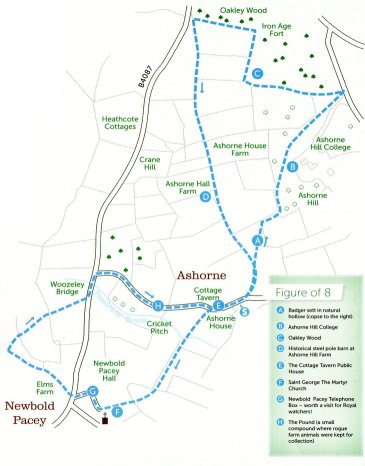Walk 3
|
Distance: |
2, 3 or 5 miles |
Time: |
1, 1½ or 2½ hours |
Terrain: |
Easy walking on mainly footpaths and bridleways |
Car Parking: |
On roadside in either village |
Refreshments: |
The Cottage Tavern pub in Ashorne |
OS Map: |
Explorer 205 Stratford & 206 EH&FC: The Green CV35 9DT, SP305577 |
Ashorne loop (3 miles): Start from The Green; head north up an unclassified road for 150 yards, until signed to the right up a steep path. Continue up the field with the hedgerow on your right. Cross the stile keeping the field fence to your left. After 75 yards cross another stile and head towards the tall stand of ‘Wellingtonia’ redwoods. From here aim towards the telegraph pole adjacent to a small copse. And then bear slightly right along a loose avenue of trees to the road. At the road one can either enter Oakley wood (and follow the meandering paths west to the Wellesbourne/ Crematorium road). Alternatively, do not leave the field, but turn sharply left and follow the edge of the wood through two fields until you reach an unclassified road. Follow the unclassified road to the left, walking through Ashorne House Farm.

Please remember to close all gates as livestock are regularly kept in the fields. Follow the hedgerow to a gate at the top of the field and over a stile into the ‘Holloway’, which leads back to The Green in Ashorne. Look out for buzzards over the woods near the badger sett, and more over Oakley wood.
Newbold Pacey loop (2 miles): From The Green, walk right (west) to the Cottage Tavern. Cross the road and follow the tall wall until you reach a wrought iron pedestrian gate set into the wall. Follow the signed path all the way to the Church at Newbold Pacey. Follow the road from the church through the village to the main road. Cross the main road through the gates inscribed ‘White Oaks’ and follow the track until it bears sharp left. At this juncture turn right on a signed path through a spinney. At the end of the spinney, walk right across a field for 30 yards to the end of a hedge. Keeping this hedge on your left, follow the edge of the field to a road. Turn left along the road to the ‘T’ junction with the road to Ashorne. Follow this road all the way back to the village. SB, LD
The Ashorne Figure of Eight Walk – Points of interest
- – Badger sett in natural hollow (copse to the right)
- – Ashorne Hill College
- – Oakley Wood
- – Historical steel pole barn at Ashorne Hill Farm
- – The Cottage Tavern Public House
- – Saint George The Martyr Church
- – Newbold Pacey Telephone Box – worth a visit for Royal watchers!
- – The Pound (a small compound where rogue farm animals were kept for collection)
St George's Church, Newbold Pacey.
There has been a place of worship on this site for almost 1000 years. In the late 19th century the building had fallen into such a state of disrepair that the decision to demolish it was taken. The present church was designed by JL Pearson, who also designed Truro Cathedral. Two of the original Norman doors are incorporated into the building. It was funded by public subscription and dedicated in 1880.
A Royalist soldier who died of wounds sustained at the Battle of Edgehill is buried in the churchyard. Inside the church there is an impressive memorial to Thomas Carew, dated 1668. He and his infant daughter are believed to have carried the plague with them when they fled from London.
Ashorne Hill
Ashorne Hill was built by American millionaire Arthur Tree in the 1890s. A farmhouse originally stood on the site and its front wall, built of blue bricks, was incorporated into the new building. A ha-ha was excavated to separate the 12 acres of gardens from the surrounding 70 acres of parkland. The soil from this was used to create the hillock which screens from sight the buildings of Ashorne House Farm. After changing hands several times Ashorne Hill was sold to the British Iron and Steel Corporation in 1939 and has not been in private ownership since.
Newbold Pacey
The settlement was mentioned in the Domesday book and was granted by the Conqueror to one of his followers. The village was deliberately depopulated in 1327, demolishing homes and dispersing occupants to increase the pasturage and tillage of the manor to make it more profitable. Over the few hundred years Newbold developed as an estate village. Local legend says that many inhabitants fled the plague in the 17th century, crossing Thelsford Brook (as it was believed that crossing water would give protection) and settling in Ashorne.
Ashorne and the Holloway
Dating from the mid 14th century and originally belonging to the manor of Newbold Pacey, Ashorne passed into the ownership of the Earls of Wawick in 1789. It is thought that marl used to build wattle and daub cottages (some of which are still standing around the village green) was excavated from the Holloway. Before the building of the ‘new’ road, the Holloway was the main route from the village to Warwick. Some sources suggest that the track has been in use since Roman times.
Ashorne House Farm
In 1887 Aaron Pain was employed by the owner of Ashorne House to develop a Shire Horse stud. He did this very successfully, winning many prizes at shows across the country. He eventually bought the farm and the land was farmed by three generations of the family from 1912 until the 1980s.
| last walk | home | Walk 3: Ashorne and Newbold Pacey | menu | next walk |